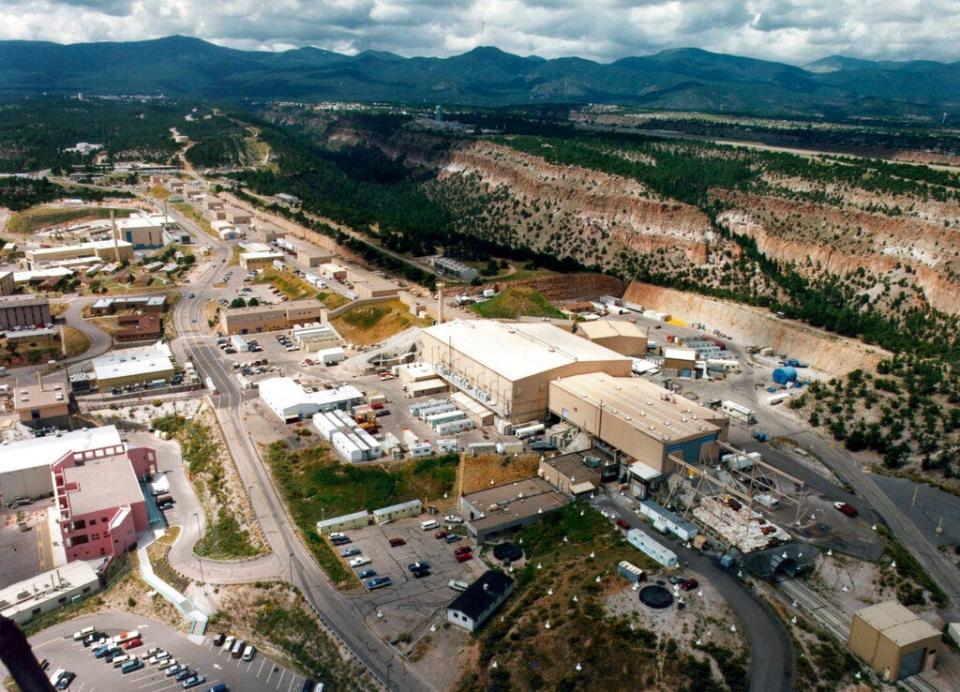Feds tout progress in cleaning up nuclear waste at Los Alamos using Carlsbad-area site
Nuclear waste managers touted progress in cleaning up radioactive materials at a national laboratory in northern New Mexico, sending most of the waste to a repository near Carlsbad.
The U.S. Department of Energy said it met several of its goals for clean up at Los Alamos National Laboratory (LANL) during the 2023 fiscal year, ending Sept. 30.
This included “exceeding” objectives for shipments of transuranic (TRU) nuclear waste from LANL to the Waste Isolation Pilot Plant, read a news release.
More: Air shaft at nuke repository near Carlsbad hits final depth amid recent safety incidents
LANL shipped 59 shipments of TRU waste to WIPP in FY 2023, records show, compared with the DOE’s goal of 40 shipments.
TRU waste is made up of clothing materials, equipment and debris irradiated during nuclear activities at DOE labs and facilities around the country.
It’s sent via truck to WIPP, about 30 miles east of Carlsbad, and disposed of via burial in an underground salt deposit about 2,000 feet underground.
More: Nuclear waste disposal permit issued for New Mexico site, WIPP to get bigger in November
The DOE said it also disposed of more 4,300 cubic meters of TRU, mixed and low-level waste from LANL in FY 2023, began the work of digging up and processing irradiated corrugated metal pipes containing TRU waste that will be eventually sent to WIPP for final disposal.
About 42 million gallons of local ground water contaminated with hexavalent chromium at the lab was also treated and remediated in the last year, the release read.
Operations at LANL met all 14 of FY 2023 objectives the DOE and State of New Mexico agreed to in a 2016 compliance order, the DOE said.

More: New Mexico could try again to challenge nuclear waste storage project in court
“I’m proud of the hard work and dedication of the Los Alamos legacy cleanup workforce in achieving our accomplishments for FY23,” said Brad Smith, president of N3B, the contractor hired to manage environmental clean up at the lab.
“We’re establishing a strong foundation of safe performance. We’re excited to begin FY24 more focused than ever on maintaining a safety conscious work environment and staying on a path of continuous improvement.”
Shipments of waste from Los Alamos to WIPP were a focus of the New Mexico Environment Department’s (NMED) recent permit issued to the DOE for the next 10 years of WIPP’s operations.
More: Here's how much of Idaho's nuclear waste was disposed of in southeast New Mexico
A clause in the renewed permit, which took effect last month, required the DOE to account for legacy waste from LANL in response to pressure from State leaders that the DOE prioritize nuclear waste from within New Mexico.
That clause called on the DOE to certify to the State every year that there was enough space at WIPP to account for LANL’s waste needs.
The permit also required the DOE to create a disposal plan specifically for legacy waste, mostly nuclear material leftover from the Cold War amid weapons development at the lab.
More: New Mexico researchers report contamination, nuclear material in oil and gas wastewater
One of two new underground disposal panels planned to be mined at WIPP will be reserved for this waste, the permit read.
“The new permit will benefit New Mexico and legacy waste clean-up from around the U.S. for years to come,” said NMED Cabinet Secretary James Kenney in a statement after the permit was issued.
But most of the waste sent to WIPP does not come from New Mexico, according to DOE records.
More: New Mexico's nuclear waste operations called into question during public forum in Carlsbad
Los Alamos National Laboratory was the fourth-biggest shipper of waste to the WIPP site since it began operations in 1999, with 1,627 shipments as of Oct. 28, records show, about 12 percent of WIPP’s total 13,715 shipments.
Idaho National Laboratory sent 7,092 shipments, followed by the now-defunct Rocky Flats Environmental Technology Site at 2,045 shipments and Savannah River Site in South Carolina which had 1,725.
The most recent records for October show four shipments from Los Alamos were received at WIPP up until Oct. 13, while 14 shipments came from Idaho during that same time.
Of the 48 shipments WIPP received in September, just one came from Los Alamos, along with one each from Savannah River and Oakridge National Laboratory in Tennessee and two shipments from Lawrence Livermore National Laboratory in California.
August also saw only a single shipment from Los Alamos, compared with 52 shipments from Idaho.
Adrian Hedden can be reached at 575-628-5516, achedden@currentargus.com or @AdrianHedden on X, formerly known as Twitter.
This article originally appeared on Carlsbad Current-Argus: Feds tout progress in nuclear waste cleanup at Los Alamos via WIPP

